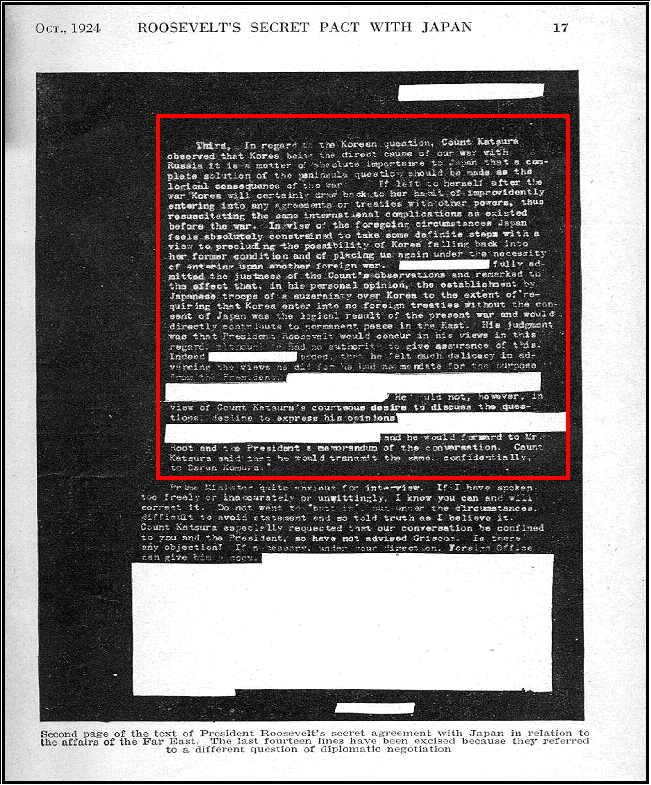On July 29, 1905, Japan´s Count Katsura met with Secretary of War (later President) William Howard Taft
to resolve the grievances between the two countries. Japan agreed to accept the US presence in Hawaii and the
Philippines and in exchange America agreed to give Japan a free hand in Korea:
"Count Katsura and Secretary Taft had a long and confidential conversation on the morning of July 27...
First, in speaking of some pro-Russians in America who would have the public believe that the victory of Japan
would be a certain prelude to her aggression in the direction of the Philippine Islands, Secretary Taft
observed that Japan´s only interest in the Philippines would be, in his opinion, to have those islands
governed by a strong and friendly nation like the United States...Count Katsura confirmed in the strongest
terms the correctness of his views on the point and positively stated that Japan does not harbor any
aggressive designs whatever on the Philippines...
Second, Count Katsura observed that the maintenance of general peace in the extreme East forms the fundamental
principle of Japan´s international policy. Such being the case,...the best and in fact the only means
for accomplishing the above object would be to form good understanding between the governments of Japan, the
United States and Great Britain...
Third, in regard to the Korean Question, Count Katsura observed that Korea being the direct cause of our
war with Russia, it is a matter of absolute importance to Japan that a complete solution of the peninsula
question should be made as a logical consequence of the war. If left to herself after the war, Korea will
certainly draw back to her habit of improvidently entering into any agreements or treaties with other powers,
thus resuscitating the same international complications as existed before the war. In view of the foregoing
circumstances, Japan feels absolutely constrained to take some definite step with a view to precluding the
possibility of Korea falling into her former condition and of placing us again under the necessity of entering
upon another foreign war. Secretary Taft fully admitted the justness of the Count´s observations and
remarked to the effect that, in his personal opinion, the establishment by Japanese troops of a suzerainty
over Korea to the extent of requiring Korea to enter into no foreign treaties without the consent of Japan was
a logical result of the present war and would directly contribute to permanent peace in the East. His
judgment was that President Roosevelt would concur in his views in this regard, although he had no authority
to give assurance of this..."
President Roosevelt concurred with Taft´s understanding in a telegram on July 31 1905:
"Your conversation with Count Katsura absolutely correct in every respect. Wish you would state to
Katsura that I confirm every word you have said..."
The Taft Katsura agreement quoted below and Roosevelt´s telegram were found in the Archives of the
Office of the Ministry of Foreign Affairs, Japan, V38 , part 1 . Copy in the Washington University Far East
Library.


Analysis of this document
The Taft-Katsura agreement was a top-secret document, however it carried the significance of any major
international treaty. It has been said to "seal Korea´s death warrant" and was a precursor to
the 1905 Japan-Korea Protectorate Treaty. Through this treaty Japan then obtained British consent to colonize
Korea under the guise of "protection". The November 17, 1905 Protectorate treaty was responsible for
the dismantling of the Korean Foreign Affairs Office, through which Korea could have officially opposed
Japan´s annexation of Dokdo under the Shimane Prefecture Inclusion of 1905.
The insidious manner in which Korea was gradually annexed can lead us to the wrong conclusion that this was a
willful, peaceful process. However, as the documents show, Korea was abandoned by allied nations with
diploatic posts in Korea, and was left without option but to enter into unfair coerced "treaties" with
Japan under duress.